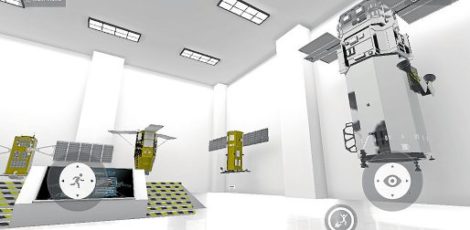It’s not Nasa, but Asti-PH has taken off

WHAT THEY LOOK LIKE Satellites WorldView3 and Kompsat-5 on display in the Asti app —SCREENGRAB FROMTHE ASTI VRS APP
Curious about what it’s like to be a space scientist in the Philippines?
Through the newly launched virtual reality simulation (VRS) app of the Department of Science and Technology (DOST), people can now explore the country’s space facilities and satellites using their cell phones.
The Advanced Science and Technology Institute (Asti) VRS app, which works like a mobile game, features the three ground receiving stations (GRS) located in Quezon City, Iloilo City and Davao City.
Available through the Philippine Earth Data Resource Observation (Pedro) Center, the stations facilitate the earth observation satellite transceiver antennas responsible for the transmission and reception of space data.
The Asti VRS app has three main control buttons: movement, jump and look around. Users can navigate through the facilities and a laboratory that showcases the different satellites developed by the country, including the foreign ones it is subscribed to.
When opening the app, there are four options or locations one can choose from to explore. The first is the Asti GRS building in Diliman, Quezon City, that houses the 3.7-meter earth observation satellite tracking antenna.
The second and largest among the three stations is located in Davao City, within the premises of the Civil Aviation Authority of the Philippines. It facilitates a 7.3-meter satellite tracking antenna. The third GRS in Iloilo City is undergoing construction and facilitates the 3.5-meter satellite tracking antenna.
The last facility that can be explored in the app is the satellite laboratory that features Philippine-made and commercial satellites from which the DOST, along with other agencies, collect space data.
Users can change their point of view and jump over the different satellites such as Diwata and Maya. A brief description of the space assets are also provided in the app.
Closing the space gap
Before the pandemic, Pedro Center opened its sites for public tours. But given the current situation, Science and Technology Secretary Fortunato de la Peña said on Wednesday at the launching of the app that this was the DOST’s “creative attempt to bring space closer to the Filipino people.”
As the Philippines continues its journey in the new space era, the Asti VRS app will help highlight the potentials of space science technology by helping the public gain a better understanding of the big picture,” he said.
The app, made through Unity Technologies’ game development platform, can be downloaded for free via Google Play Store.